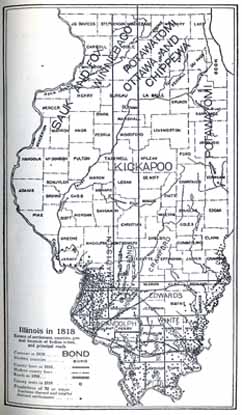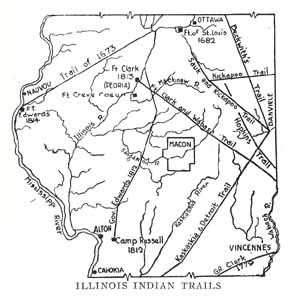|
Louis Joliet and Father
Marquette had been sent from Canada to explore the mighty western
river which the Indians called the Mississippi. They had come
up the Illinois river, and, lured on by the Charm of the scenery
unfolding before them, had turned off the main river and follows the
Sangamon for a distance.
Later explorers in Illinois such
as Robert de LaSalle and Father Louis Hennepin, were just as
enthusiastic as these first two. Father Hennepin called the
Illinois country the "Delight of America."
ILLINOIS BEFORE 1818
Illinois was a part of the vast
territory in this country first claimed by the Spanish, and which
they called Florida. Afterwards it was explored and settled by
the French, and then later was taken by the British. At last
it was conquered for Virginia by the successful expedition of the
courageous soldier, George Rogers Clark, where he captured Kaskaskia
and Vincennes, and became a part of the County of Illinois created
by the legislature of Virginia.1
The County of Illinois included
territory now known as the states of Illinois, Ohio, Indiana,
Wisconsin and Michigan.
In 1784 the County of Illinois was
ceded by Virginia to the United States. In 1787 Congress
passed an ordinance for the government of the territory, which was
then called the Northwest Territory.
In 1800 the Territory of Indiana
was organized, including what is now the state of Illinois, and in
1809 the Territory of Illinois came into being. What is now
Wisconsin was a part of that territory.
Ninian Edwards was appointed
territorial governor, and the first territorial legislature convened
at Kaskaskia in 1812.
In 1818 the present boundary was
fixed and Illinois became a state.
MAKING MACON COUNTY
In the course of the various
changes that have been made in boundaries of counties the territory
that is now Macon county has been a part of the following counties:
Knox, St. Clair, Madison, Edwards, Crawford, Clark, Fayette and
Shelby.
At the time that Illinois was
admitted to the union as a state, it had a population of about
35,000, the sections settled being on the opposite sides of the
state, on the Mississippi on the west and the Ohio and Wabash rivers
on the east and south, thus providing connections by water with the
outside world. The river bottom of the

Mississippi and the neighborhood of the U.S.
saline in Gallatin county were the most thickly populated places.
THE INDIANS
The interior of the state was
uninhabited, except by Indians. The Kickapoos were still in
central Illinois and the Sacs and the Foxes in the territory
northwest of the Illinois river2.
Black Hawk, the great
Sac chief, was the last of the Indian leaders to question the
domination of the white race in Illinois³.
After his final defeat in 1832, and his removal to Iowa, the north
part of the state was ready for settlement by the white race4.
The last remaining Indians in central Illinois, the Kickapoos, by
this time had removed to Kansas, and eventually went to Texas.
NOT ON IMPORTANT
TRAILS
Macon county probably
never was the site of an Indian village, nor was it crossed by
important Indian trails, yet the Indian wandered over its hills and
prairies to hunt game, and up and down the banks of the Sangamon to
fish in its waters. Often spots in this county were chosen for
camp grounds, at least one attraction, no doubt, being the fine
springs of water.
One of the Indian camping grounds in the county was
on the Hockaday farm southwest of Emery. Many arrow heads were
found there in later years.
According to
traditions and judging from evidences found, there were also Indian
camp grounds at Sulphur Springs near Mt. Zion, at Boiling Springs in
Hickory Point township, and at Dantown in Friend's Creek township.
 An Indian trail once crossed the
Sangamon in Friend's Creek township. It finally became a
public road, but in later years disappeared. Traces of an
Indian trail were found on the Samuel Powers farm northeast of
Decatur.
Even after the white man settled
in the county, bands of Indians were frequently seen, but usually
they caused no trouble. It is related, however, that in the
fall of 1828 a band of Kickapoos, which had camped on Long Creek to
hunt, trap and fish, began making depredations on hogs and poultry
in settlements in the vicinity.
One band was known to have made
threats against the Ward families living south of the river.
John and William Ward, heading a group of men from the neighborhood,
among them James Edwards and Joshua Perdue, went after the red men
one day, and overtook them on the prairie a short distance east of
Mt. Zion. There were about twelve Indians and their squaws in
the party.
Smith Mounce of the Ward party
took a gun from one of the Indians, but John Ward told him to return
it. Then Ward gave the Indians orders to move on, and they
moved.
That was the last time Indians
were seen in any numbers around Decatur. Sometimes an
occasional stray one would be seen, and some of the older residents
say that one Indian lived for the rest of his life out in the
neighborhood of the Stevens settlement5.
PRAIRIES BEAUTIFUL
Picture, if you can, Macon county
as it was a hundred years ago.
Writers of that day have left
their descriptions of the marvelous beauty of the prairies with us,
and to these we must turn for a glimpse of the scene.
The century-ago traveler saw vast
stretches of prairie grass, ablaze with blossoms of wild flowers of
every hue. Moses writes:
"The prairies were marvels of beauty. The marvelous carpet of
vendure and flowers in rich profusion and infinite diversity made of
the prairies a garden of the Magi."
With the advance of the seasons
the scene changed. After the blue of the violet and the
bluebell in the spring came the more vivid blossoms of the summer
time, and then came the brilliant fall flowers.
One writer tells that along the
edges of sloughs were a species of red phlox which were dazzling.
The wild roses, the black-eyed Susans, the golden-rod, the milkweed,
the sunflowers, and asters, the ironweed, and the multitude of other
blossoms came and went, making a panorama at all times of flowers
which never failed to impress the beholder. A traveler then
could be excused for thinking he was in the Garden of Eden6.
And the prairie grass! Growing sometimes so
tall that the little children easily got lost in it!
It was the terrible prairie fires which kept the
prairies from becoming forests, and the tall grass was the fuel for
these fires. Reynolds says:
"The fires were grand and terrible as they advanced with a mighty
roar, destroying everything above ground."
Yet it was not the beauty of the prairies that
attracted the early pioneers who came and settled in Macon county.
They came because they had heard of the agricultural wealth of the
land. They were men who wanted room, and naturally they came
to a new country for it. They were not satisfied with small
parcels of ground.
The "rich country of the Sangamon," of which Macon
county was a part, was becoming known. Reports of the
fertility of the soil were spread.
It was not to be child's play to blaze the way in
a new land. This was not the place for the idler and the
coward, but for the staunch and the brave, for the man accustomed to
hardships.
Here were acres upon acres of fertile soil,
untouched by the plow, but full of promise for the future. So
the pioneers came.
1 Three kinds of titles had to be dealt
with in the state of Illinois, the old French claims, military
rights under the Virginia rule, and head rights under the Act of
1783. The oldest titles in Macon county were from land grants
under the Act of Congress.
2 In Reynolds History is told the story of a white woman,
Mrs. James Gilham, Sr., and her children who were stolen from their
home in Kentucky and taken to the Kickapoo village in Sangamon
county, crossing the future site of Decatur in the journey. It
was in the year 1799. The Kickapoo town was located on Salt
Creek, northeast of Elkhart Grove.
3 J. Anderson Draper said that when he was a small child
in Whitmore township he was Black Hawk pass through that section,
with several other Indians, on their way to northwest Illinois.
This was only a few months before the Black Hawk war.
4 Following his defeat, Black Hawk was taken on a trip
through the east, the object being to show him the power of the
white man. On his return to Iowa after that trip he said:
"Rock River was a beautiful country. I loved my towns, my corn
fields and the homes of my people. I fought for it. It
is now yours. Keep it as we did."
5 Ben Frazee used to say that when he was a child, there
was still fear of the Indians in the county. If the dog began
to bark at night Mother Frazee became so frightened that she and the
kiddies hid underneath the puncheons of the floor. Once they
did see Indians on Stevens creek. The Indians were then
leaving the county.
6 Mrs. Jane M. Johns says in her "Personal Recollections"
that shortly after her arrival in Decatur she met a peddler at the
Macon house who said that he wanted to bring his old New England
father to this country just once, so that he would not be so much
taken with surprise when he went to heaven.
<PREVIOUS>
<NEXT>
<CLICK
HERE TO RETURN TO TABLE OF CONTENTS> |